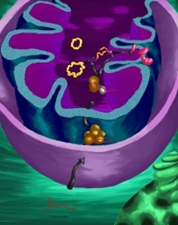UCLA scientists discover protein that shuttles RNA into cell mitochondria
By By Kim Irwin | 13 Aug 2010
In a new study, UCLA researchers have uncovered the role played by an essential cell protein called polynucleotide phosphorylase (PNPASE) in shuttling RNA into the mitochondria, the energy-producing "power plant" of the cell.
 |
| Cell protein PNPASE shuttles RNA into mitochondria. |
In the current study, scientists from UCLA's Jonsson Comprehensive Cancer Center, the UCLA Department of Chemistry and Biochemistry and the UCLA Department of Pathology and Laboratory Medicine found that when the expression of PNPASE was reduced, RNA import decreased, impairing the processing of mitochondrial genome-encoded RNAs.
Reduced RNA processing inhibited the translation of proteins required to maintain the electron transport chain which handles the conversion of oxygen into adenosine triphosphate, or ATP, the energy currency of a cell.
With reduced PNPASE, unprocessed mitochondrial RNAs accumulated, protein translation was inhibited and energy production was compromised, leading to stalled cell growth.
The study was published Aug. 5 in the peer-reviewed journal Cell.
"This discovery tells us that PNPASE regulates the energy producing function of mitochondria by mediating cytoplasmic RNA import," said Dr. Michael Teitell, a professor of pathology and laboratory medicine, a Jonsson Cancer Center researcher and co-senior author of the study. "The study yields new insight for how cells function at a very fundamental level. This information provides a potential new pathway to control mitochondrial energy production and possibly impact the growth of cells, including certain types of cancer cells."
Mitochondria are described as cellular power plants because they generate most of a cell's energy supply. In addition to supplying energy, mitochondria also are involved in a broad range of other cellular processes, including signaling, differentiation, death, control of the cell cycle and growth.
The UCLA finding could have implications for studying and treating certain cancers that rely on cellular energy to grow and spread, as well as mitochondrial disorders such as neuromuscular diseases. It could also result in new ways to think about attacking neurodegenerative disorders such as Parkinson's and Alzheimer's diseases, which have recently been linked to the function of mitochondria.
"When we're talking about looking for ways to cure cancer, we fundamentally need to understand what makes cells grow and die, and the mitochondrion is right at the heart of these issues," said Carla Koehler, a professor of chemistry and biochemistry, a Jonsson Cancer Center researcher and co-senior author of the study.
"This new and novel pathway for transporting RNA into the mitochondria is shedding new light on the evolving role and importance of mitochondria function in normal physiology and a wide variety of diseases. If we can understand how this pathway functions in healthy cells, we could potentially uncover defects that help in transforming normal cells into cancer cells."
PNPASE was identified in 2004 by Teitell and his team as they attempted to find proteins that interact with TCL1, a human lymphoma-promoting cancer gene that has been used to generate genetic models of lymphocyte cancer.
Mass spectrometry uncovered PNPASE, which had a signature sequence that suggested it trafficked into and localized within the mitochondria of cells. Once localized, Teitell, Koehler and postdoctoral fellow Geng Wang turned their attention to the function of PNPASE, which generated the unexpected results reported in this study.
Prior to their discovery, it was not known what pathway was used to get RNA into the mitochondria. PNPASE mediates the movement of RNA from the cell cytoplasm, the area of the cell enclosed by the cell membrane, into the matrix of mitochondria, where the mitochondrial genome is located. The protein acts as receptor and binds to cytoplasmic RNAs that have a particular stem-loop signature sequence, mediating import, Teitell said.
Without this RNA import, the cell lacks the machinery to assemble the mitochondria's energy source, Koehler said.
"The cell would lose most of its ability to make energy," she said. "It would be crippled. Mitochondria are fantastically complex, and our study reveals another cellular pathway in which these tiny but important powerhouses participate in essential cell activities, such as the generation of energy essential for life."
The study was funded by the National Institutes of Health, the California Institute for Regenerative Medicine, the American Heart Association, the Leukemia and Lymphoma Society, and an NIH Nanomedicine Roadmap Grant.
UCLA's Jonsson Comprehensive Cancer Center has more than 240 researchers and clinicians engaged in disease research, prevention, detection, control, treatment and education. One of the nation's largest comprehensive cancer centers, the Jonsson Center is dedicated to promoting research and translating basic science into leading-edge clinical studies. In July 2010, the center was named among the top 10 cancer centers nationwide by U.S. News & World Report, a ranking it has held for 10 of the last 11 years.






























